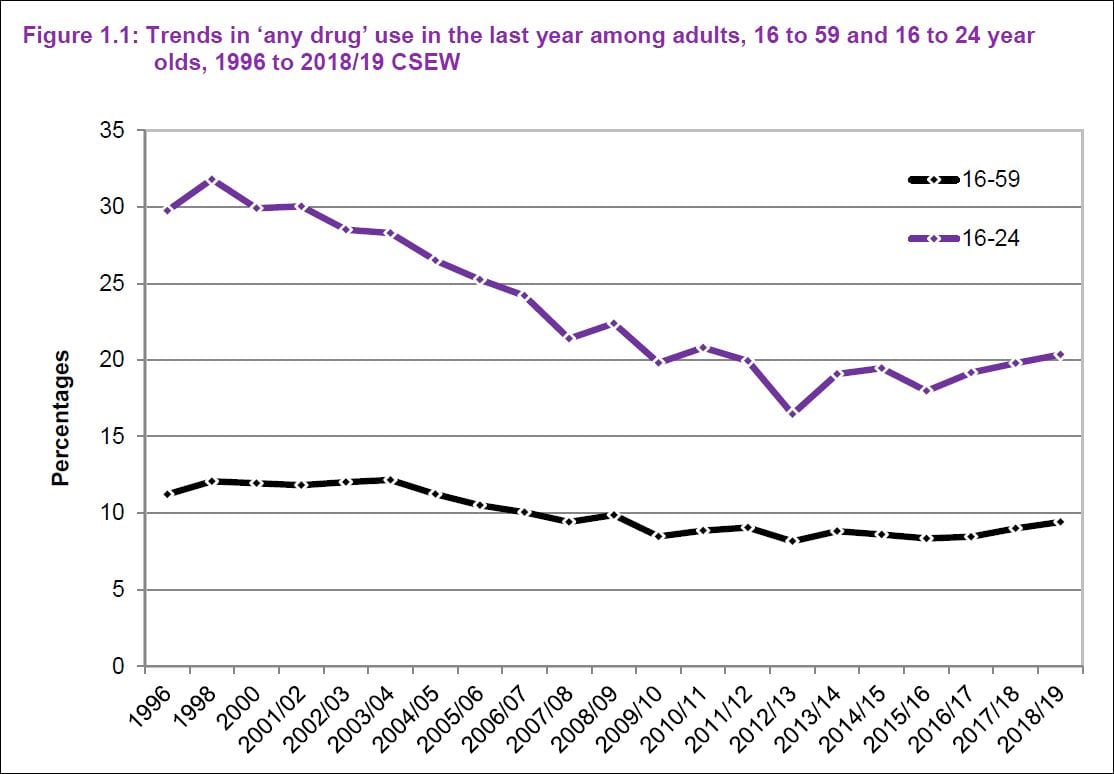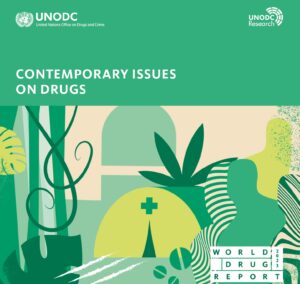Young people using more cocaine and Ecstasy (again)
The latest official drug use statistics: “Drug Misuse: Findings from the 2018/19 Crime Survey for England and Wales” were released last Thursday (19 September 2019) by the Home Office and Office for National Statistics.
Before turning to the figures, it’s good to remember that the CSEW figures are recognised as a reliable measure of mainstream recreational drug use, rather than problematic use. This is because CSEW is a household survey and doesn’t include people who are homeless, in temporary accommodation or in prison. The CSEW drug module has been running since 1996 so provides an excellent comparison of drug user over time.
CSEW reports separately on the drug use of 16-24 year olds from 25-59 year olds and, for the first time of 60-74 year olds.
Main findings
- Around 1 in 11 (9.4%) adults aged 16 to 59 had taken a drug in the last year. This equated to around 3.2 million people. While the latest estimate was not significantly higher than the previous year’s (9.0%, in the 2017/18 CSEW) there has been an upward trend since the 2015/16 survey (8.3%). The latest estimate is similar to the 2008/09 CSEW (9.9%) but remains lower than in 1996 (11.2%), when the time series began.
- Around 1 in 5 (20.3%) adults aged 16 to 24 had taken a drug in the last year, which equates to around 1.3 million people. Whilst not significant, there has been an apparent upward trend in last year drug use among adults aged 16 to 24 since 2015/16 (18.0%), with the latest estimate similar to the 2017/18 survey (19.8%). The latest estimate was lower than in 1996 (29.7%), but there was no significant change compared with a decade ago (22.4% in 2008/09 CSEW).
- The survey measure of recent drug use showed that around 1 in 20 (5.0%) adults aged 16 to 59 had taken a drug in the last month. Prevalence of ‘any drug’ showed an increase compared with 2017/18 for adults aged 16-59 (4.3%), however there has been a general downward trend since 2003/04 (7.3%).
- Around 1 in 9 (11.4%) young adults aged 16 to 24 had taken a drug in the last month.There was no significant change for adults aged 16 to 24 compared with 2017/18 (9.6%) or with a decade ago. Similarly to adults aged 16 to 59, there has been a general downward trend, for which drug use in the last month has decreased from a high of 20.8 per cent in 1998.
- Around one-third (34.2%) of adults aged 16 to 59 had taken drugs at some point during their lifetime. This was a similar level to the previous year’s survey (34.6% according to the 2017/18 CSEW) but an increase compared with the 1996 survey (30.5%).
- Around 1 in 25 (3.7%) adults aged 16 to 59 had taken a Class A drug in the last year,which equates to around 1.3 million people. This has increased compared with the 1996 survey(2.6%) and is similar to the previous year’s estimate (3.5%). While there is some fluctuation from year-to-year, there has been a general upward trend in class A drug use since the 1996 survey.
- Among young adults aged 16 to 24, 8.7 per cent had taken a Class A drug in the last year.Although there appears to have been an upward trend in the use of Class A drugs, the changes are not statistically significant compared with the previous year (8.4%) and a decade ago(8.0%). There was an increase compared with the 2011/12 estimate (6.2% to 8.7%), with the 2018/19 estimate the highest since 2002/03 (8.9%). This is mainly driven by an increase in powder cocaine and ecstasy use.
Less common drugs
- Use of amphetamines decreased among both 16 to 59 and 16 to 24 year olds. For those aged 16 to 59, prevalence of amphetamine use has followed a general downward trend since a high of 3.3 per cent in 1996 to 0.6 per cent in 2018/19. Use of amphetamines followed a similar trend for those aged 16 to 24, falling from a high of 11.7 per cent in 1996 to 1.0 percent in 2018/19.
- Ketamine use has increased from a decade ago across both age groups. For adults aged 16 to 59, use of ketamine has fluctuated in the last decade, with the latest estimate at 0.8 per cent, an increase compared with 2008/09 (0.5%). Use among adults aged 16 to 24 also showed a lot of variation in the last decade, although there was a general increase from1 .9 per cent in 2008/09 to 2.9 per cent in 2018/19, with a particularly large rise between 2016/17 and 2017/18 (1.3% to 3.1% respectively).
- Nitrous oxide continued to be the second most used drug among 16 to 24 year olds,with 8.7% having used it, a similar proportion (8.8%) to last year’s survey. This equates to around 552,000 young adults who used nitrous oxide in the last year. Use of new psychoactive substances among 16 to 24 year olds in the 2018/19 survey was also at a similar proportion to last year’s survey (1.4% and 1.2% respectively).
Noteworthy trends
- As with findings in previous survey years, younger people were more likely to take drugs than older people. The level of ‘any drug’ use in the last year was highest amongst 16 to 19 year olds (18.4%) and 20 to 24 year olds (21.7%), although prevalence was lower for both these age groups compared with when the series started in 1996 (31.8% and 28.1% respectively). The level of any drug use declined with age in general, with prevalence in the oldest age category at 1.7% of 55 to 59 year olds.
- Men (12.6%) were around twice as likely as women (6.3%) to take any drug in the last year.
- Higher prevalence rates of drug use were associated with higher frequency of visits to pubs, bars and nightclubs. For example, use of any Class A drug in the last year was around 11 times higher among those who had visited a nightclub at least four times in the past month (24.5%),compared with those who had not visited a nightclub in the past month (2.3%).
- People living in urban areas (9.8%) were more likely to have taken any drug in the last year than those living in rural areas (7.7%).
- People with self-reported lower levels of happiness were more likely to have taken any drug in the last year than those with self-reported higher levels of happiness. Around 1 in 5 (19.3%) adults who had classified themselves as having low levels of happiness reported using ‘any drug’ in the last year. In comparison, among those who were classified as having very high levels of self-reported happiness, around 1 in 16 (6.2%) had used a drug in the last year.
- Around two fifths (41.0%) of adults aged 16 to 59 claimed that it would be very easy or fairly easy for them personally to obtain illegal drugs within 24 hours if they wanted them. Around one in five(19%) thought it would be very easy, an increase from 14.0 per cent in 2016/17.









One Response
I feel that it is so unfortunate that we have a drug problem in the USA and for that matter anywhere in the world.
It seems to me that the problems starts when the people are just kids and they are hooked. There needs to be a good way of stopping the trend. Border enforcement for illegal drugs helps somewhat but the fact is so many of these drugs are so addicting one you are hooked you can’t stop.
Maybe drug users should be socially shamed? I don’t know but there has to be a better way.